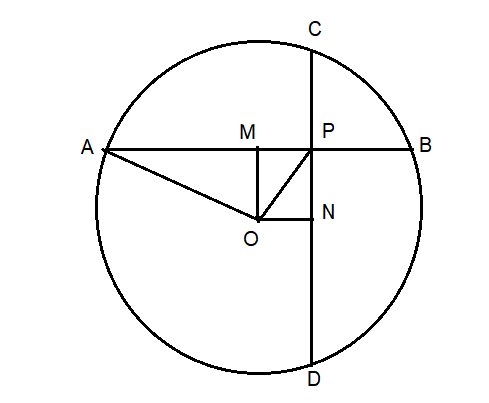PRACTICE QUESTIONS ON CIRCLES AND CYCLIC QUADRILATERALS
Subscribe to our ▶️ YouTube channel 🔴 for the latest videos, updates, and tips.
Question 1 :
In the given figure, AB and CD are the parallel chords of a circle with centre O. Such that AB = 8cm and CD = 6cm. If OM ⊥ AB and OL ⊥ CD distance between LM is 7cm. Find the radius of the circle.

Solution :
Let us join the points OC, OD, OA and OB.
OA = OB = OC and OD are equal in length and it is radius.
Let OL = x
In triangle OLD,
CL = CD = 3 cm
OL2 + LD2 = OD2
x2 + 32 = OD2
OD2 = x2 + 9 ------------(1)
In triangle OAB,
OM = 7 - x
AM = BM = 4 cm
OM2 + MB2 = OB2
(7 - x)2 + 42 = OB2
OB2 = (7-x)2 + 16 ------------(2)
(1) = (2)
(7-x)2 + 16 = x2 + 9
49 - 14x + x2 + 16 - x2 - 9 = 0
-14x + 56 = 0
x = 56/14 = 4
By applying the value of x in (1), we get
OD2 = 42 + 9
OD2 = 16 + 9 = 25
OD = 5 cm
Question 2 :
The arch of a bridge has dimensions as shown, where the arch measure 2 m at its highest point and its width is 6 m. What is the radius of the circle that contains the arch?

Solution :

DB = 2 m and DB = 3 m
CE = CB = AC (radius)
Let DC = x
In triangle CDB,
CB2 = CD2 + DB2
CB2 = x2 + 32 ---(1)
CE = x + 2
By applying the value of CE = x + 2 (CB) in (1), we get
(x + 2)2 = x2 + 9
x2 + 4x + 4 - x2 - 9 = 0
4x - 5 = 0
x = 5/4
x = 1.25
CE = 1.25 + 2 = 3.25 m
Question 3 :
In figure, <ABC =120 , where A,B and C are points on the circle with centre O. Find <OAC ?

Solution :
Question 4 :
A school wants to conduct tree plantation programme. For this a teacher allotted a circle of radius 6m ground to nineth standard students for planting sapplings. Four students plant trees at the points A,B,C and D as shown in figure. Here AB = 8m, CD = 10m and AB is perpendicular to CD. If another student places a flower pot at the point P, the intersection of AB and CD, then find the distance from the centre to P.

Solution :

AM = (1/2) AB
AM = (1/2)8 = 4
CN = (1/2) 10 = 5
OA = 6
OA2 = OM2 + MO2
62 = OM2 + 42
36 - 16 = OM2
OM = √20 = 2√5
OD2 = ON2 + ND2
62 = ON2 + 52
36 - 25 = ON2
ON = √11
OMPN is a rectangle and OP is a diagonal.
OP2 = ON2 + PN2
OP2 = √112 + (√20)2
OP2 = 11 + 20
OP = √31 = 5.56 (approximately)
Question 5 :
In the given figure, ∠POQ = 100° and ∠PQR = 30°, then find ∠RPO .

Solution :
By Inscribed Angle Theorem,
∠PRQ = 1/2 ⋅ m∠arc PQ
∠PRQ = 1/2 ⋅ 100°
∠PRQ = 50°
In ΔOPQ,
OP = OQ = Radius
So, ΔOPQ is an isosceles triangle.
Because ∠POQ = 100°,
∠OPQ = ∠OQP = 45°
In ΔPQR,
∠RPQ + ∠PQR + ∠PRQ = 180°
Substitute.
∠RPQ + 30° + 50° = 180°
∠RPQ + 80° = 180°
Subtract 80° from each side.
∠RPQ = 100°
∠RPO = ∠RPQ - ∠OPQ
∠RPO = 100° - 45°
∠RPO = 55°
Subscribe to our ▶️ YouTube channel 🔴 for the latest videos, updates, and tips.
Kindly mail your feedback to v4formath@gmail.com
We always appreciate your feedback.
About Us | Contact Us | Privacy Policy
©All rights reserved. onlinemath4all.com
Recent Articles
-
90 Degree Clockwise Rotation
Dec 18, 25 09:42 AM
90 Degree Clockwise Rotation - Rule - Examples with step by step explanation -
10 Hard SAT Math Questions (Part - 40)
Dec 18, 25 08:49 AM
10 Hard SAT Math Questions (Part - 40) -
Specifying Units of Measure
Dec 15, 25 07:09 PM
Specifying Units of Measure

